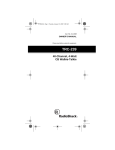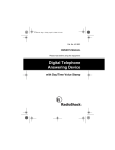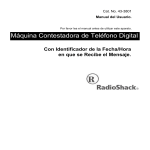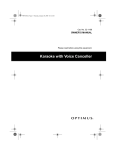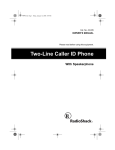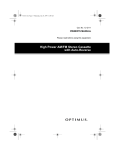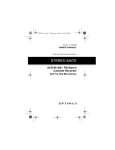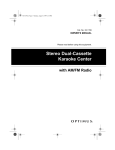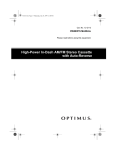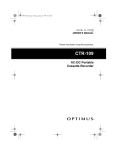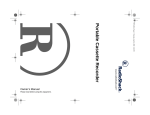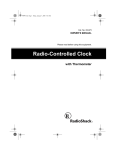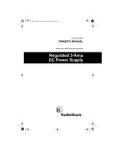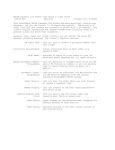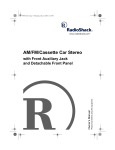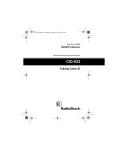Download Radio Shack AM/FM Cassette Car Stereo Owner`s manual
Transcript
12-2004a.fm Page 1 Friday, January 21, 2000 4:45 PM Cat. No. 12-2004 A OWNER’S MANUAL Please read before using this equipment. AM/FM Cassette Car Stereo with Auto-Stop AM/FM Stereo Cassette Player 12-2004a.fm Page 2 Friday, January 21, 2000 4:45 PM FEATURES Your RadioShack AM/FM Cassette Car Stereo has an auto-stop cassette deck, locking fast-forward, and tone and balance controls designed to make your stereo’s operation simple and convenient. Mono/Stereo Control — lets you select FM reception in stereo on strong stations or monaural reception on weak stations. Caution: Use common sense. Do not change your stereo’s settings in heavy traffic or during hazardous driving conditions. This stereo’s features include: Adjustable Shaft Spacing — fits almost all shaft-type installations. Auto-Stop — stops the tape when it reaches the end, to reduce wear on your tape and the cassette deck. Locking Fast-Forward — lets you quickly move the tape forward. LO/DX Button — lets you adjust the tuner’s sensitivity. FM Stereo Indicator— lights when the radio receives a stereo FM signal. Backlit Display — lets you easily see the station the radio is tuned to. Tone and Balance Controls — let you adjust high and low sounds and the balance between the left and right speakers, so you can tailor the sound to suit your preferences. © 2000 Tandy Corporation. All Rights Reserved. RadioShack is a registered trademark used by Tandy Corporation. 2 12-2004a.fm Page 3 Friday, January 21, 2000 4:45 PM CONTENTS Installation ............................................................................................................... Before You Begin the Installation ........................................................................ Preparing the Mounting Area ....................................................................... Routing Speaker Wires ................................................................................ Making the Connections ..................................................................................... Using an Adapter Harness ........................................................................... Connecting Ground, Power, and Optional Components .............................. Connecting Speakers ................................................................................... Connecting the Antenna .............................................................................. Completing the Connections ........................................................................ Testing the Connections ..................................................................................... Mounting the Stereo ........................................................................................... Setting the Shaft Spacing ............................................................................ Completing the Installation .......................................................................... 4 4 4 4 4 5 6 7 7 7 7 8 8 8 Operation ............................................................................................................... Turning the Stereo On and Off ......................................................................... Adjusting the Sound/Tuning .............................................................................. Playing a Cassette ........................................................................................... Fast-Forward and Rewind .......................................................................... 11 11 11 11 12 Care and Maintenance .......................................................................................... The FCC Wants You to Know ........................................................................... Cleaning the Tape-Handling Parts .................................................................... Restoring Tape Tension and Sound Quality ..................................................... Replacing the Fuse .......................................................................................... 13 13 13 14 14 Specifications ....................................................................................................... 15 3 12-2004a.fm Page 4 Friday, January 21, 2000 4:45 PM INSTALLATION BEFORE YOU BEGIN THE INSTALLATION Before you install your stereo, we recommend you read through all the instructions in this Owner’s Manual. You should be able to answer all of these questions about your vehicle’s electrical and sound systems. • Which terminal in my vehicle’s fuse box is for accessories? • How do I connect a wire to the fuse box? • Which of the stereo’s wires is the power wire and which are speaker outputs? Also, be aware that installation in your vehicle might require cutting or modifying your vehicle. Place the stereo as close as possible to the selected mounting location. We recommend that you test the connections by temporarily connecting the ground and power wires, your speakers, and an antenna. After you test the connections (see “Testing the Connections” on Page 7), disconnect the stereo, mount it in your vehicle, and then reconnect it. The instructions in this manual are arranged in this order. Caution: Be sure your speakers can handle 7 watts of power (3.5 watts per channel). Each speaker must have an impedance of at least 4 ohms. Your local RadioShack store carries a full line of speakers. 4 Preparing the Mounting Area Before you mount the stereo, make sure you have all the necessary materials. Then confirm that the stereo fits your vehicle’s mounting area. This autosound stereo system is a shaft-type unit that requires a 115/16-inch (50 mm) high by 61/2-inch (164 mm) wide by 43/4-inch (120 mm) deep mounting area. Note: If the mounting area is too large, you might be able to mount the stereo with an in-dash installation kit, available at your local RadioShack store. Follow the installation kit’s instructions to mount the stereo. Caution: Be sure to avoid obstructions behind the mounting surface. Routing Speaker Wires If you install speakers, avoid routing the speaker wires near moving parts or sharp edges. You can usually route them along the wiring channel beneath the vehicle’s door facings by carefully removing the molding that holds the carpet in place. After you route the speaker wires, replace the molding. MAKING THE CONNECTIONS The supplied harness with the 14-pin connector includes all the lead wires you need to connect the stereo to ground, power, some optional components, and speakers. 12-2004a.fm Page 5 Friday, January 21, 2000 4:45 PM Important: Do not cut these wires. If you cut any wire, you cannot obtain a refund or exchange on this product. However, your local RadioShack store will provide warranty service if you cut a wire and find the product is defective. You might need additional wire, depending on your individual autosound system, to complete the connections. Your local RadioShack store carries a full line of wire and wire management accessories. Note: The wires in the wiring harness have these colors and labels. AMP REMOTE TURN ON 500 MA POWER LEAD (B+) GROUND (–) Blue Red Black Cautions: • For added safety and to protect your stereo, disconnect the cable from your vehicle’s negative (–) battery terminal before you begin. • You must connect the GROUND (–) and POWER LEAD (B+) wires first, then make all other connections as described in the following sections before you plug the harness with the 14-pin connector into the stereo. If you do not make connections in the order shown, damage to the stereo is possible if any wire connections are made incorrectly. • You must connect a separate wire to each speaker terminal as described in the following procedure. Do not use a common wire or chassis ground for any speaker connection. Using an Adapter Harness If you are replacing an existing stereo, or if your vehicle has been factory-wired for autosound components, you might be able to use an adapter harness to connect the power and speakers. RadioShack stores carry adapter harnesses for most vehicles. Follow the directions that come with the adapter harness to temporarily connect the ground and power wires, optional components, and speakers. Then go to “Connecting the Antenna” on Page 7. 5 12-2004a.fm Page 6 Friday, January 21, 2000 4:45 PM Connecting Ground, Power, and Optional Components Follow these steps to connect the supplied harness with the 14-pin connector to ground, primary power, and optional components. Stereo Blue Red AMP REMOTE TURN ON 500 MA MAX POWER LEAD (B+) White White/Black Gray Black GROUND (–) Gray/Black SPEAKER LEFT SPEAKER RIGHT 1. Disconnect the cable from your vehicle’s negative (–) battery terminal. 2. Connect the black GROUND (–) wire to a chassis ground, such as a metal screw attached to a metal part of the vehicle’s frame. Be sure that the screw is not insulated from the chassis by a plastic part. 3. Connect the red POWER LEAD (B+) wire (with in-line fuse holder) to a point in your vehicle’s fuse block that has power only when you turn the vehicle’s key to either the accessory (ACC) or START position. This connection turns on the stereo when you turn on the ignition or turn the key to ACC, and turns off the stereo when you turn off the ignition. This prevents your vehicle’s battery from being drained if you leave the stereo on when you turn off the ignition. 4. Cut the loop at the end of the blue AMP REMOTE TURN ON 500MA MAX wire, strip about 1/2 inch of insulation from its end, then connect it to any optional equipment (designed to run from a switched source) that you want the stereo to turn on and off (such as a power antenna). This wire does not provide power to the components. It simply turns them on or off. 6 12-2004a.fm Page 7 Friday, January 21, 2000 4:45 PM If you do not use this wire, secure it with a wire tie and do not let its bare wire ends touch metal (if you cut it). Connecting Speakers 1. Connect the gray wire to the right speaker’s positive terminal. This terminal is usually marked with a plus (+) sign or red mark. 2. Connect the gray/black wire to the right speaker’s negative terminal. This terminal might be marked with a minus (–) sign or it might not be marked at all. 3. Connect the white wire to the left speaker’s positive terminal. 4. Connect the white/black wire to the left speaker’s negative terminal. Connecting the Antenna Connect the vehicle’s antenna cable to the antenna jack on the back of the stereo. Completing the Connections After you have securely made all other connections, plug the harness’ connector into the stereo’s 14-pin wiring socket. 14-Pin Wiring Socket 14-Pin Connector Then reconnect the cable to the vehicle’s negative (–) battery terminal. TESTING THE CONNECTIONS Turn on your vehicle’s ignition then turn OFF/VOL clockwise until it clicks. The front of the stereo lights. If the stereo does not work, immediately disconnect the cable from your vehicle’s negative (–) battery terminal. Then recheck your connections. Antenna Cable After you verify that the front of the stereo lights, follow the instructions in “Mounting the Stereo” on Page 8. 7 12-2004a.fm Page 8 Friday, January 21, 2000 4:45 PM MOUNTING THE STEREO Setting the Shaft Spacing 3. Loosen the shaft nuts on both shafts. Then move each shaft positioner to the correct pair of holes as shown. The size of pre-existing openings in the dash or installation kit determines the best spacing between the stereo’s shafts (knobs). The space between the shafts is preset to 51/8 inches (130 mm). If needed, you can change the spacing to 53/8 inches (136 mm), 59/16 inches (142 mm), or 513/16 inches (148 mm). Measure the size of the pre-existing openings in the dash or installation kit. Then, if you need to change the shaft spacing, follow these steps. 1. Make sure the ignition is turned off, then disconnect the cable from your vehicle’s negative (–) battery terminal. 2. Disconnect the wiring harness and the antenna. Shaft Nut Shaft Positioner Note: If necessary, you can turn one or both shaft positioners 180° so they fit the mounting holes. 4. Tighten the shaft nuts on both shafts. Completing the Installation Once you verify that the stereo is connected properly (see “Testing the Connections” on Page 7), follow these steps to mount the stereo. 1. Make sure the ignition is turned off, then disconnect the cable from your vehicle’s negative (–) battery terminal. 2. Make sure the wiring harness and antenna are disconnected. 8 12-2004a.fm Page 9 Friday, January 21, 2000 4:45 PM Metal Strap Self-Tapping Screw Stereo Gasket Nut Trim Plate Dashboard Washer Shaft-Spacing Adapter Outer Knob Nut Washer Nut Washer Washer Inner Knob Nut 3. Place one of the supplied nuts and washers on each shaft, then tighten the nuts about halfway up the shafts. 4. From behind the dashboard, insert the shafts through the holes in the mounting surface. 5. Adjust the nuts on the shafts until the stereo’s front panel lines up properly with the dashboard. If additional front panel support is needed, you can insert the supplied gasket. 6. Place another supplied washer and nut on each shaft, then tighten the nuts to secure the stereo against the dashboard. 7. Place the supplied trim plate and one pair of the shaft-spacing adapters over the shafts. Select the pair of shaft-spacing adapters that fit over the shafts and into the cutouts in the trim plate. 8. To further secure the stereo, use the supplied self-tapping screw, nut, and washer to attach one end of the supplied metal strap to the bolt on the back of the stereo. If necessary, bend the metal strap to fit your vehicle’s mounting area. Then attach the other end of the strap to a solid metal part of the vehicle, using an existing bolt or the supplied self-tapping screw. This strap also ensures that the stereo is properly grounded. 9 12-2004a.fm Page 10 Friday, January 21, 2000 4:45 PM 9. Place another supplied washer and nut on each shaft, then tighten the nuts to secure the shaft-spacing adapters against the stereo. 10. Place the supplied inner and outer knobs on the shafts. 11. Reconnect the wiring harness and the antenna. 12. Reconnect the cable to the vehicle’s negative (–) battery terminal. 10 12-2004a.fm Page 11 Friday, January 21, 2000 4:45 PM OPERATION TURNING THE STEREO ON AND OFF To turn on the stereo, turn OFF/VOL (the inner knob on the left side of the stereo) clockwise until it clicks. To turn off the stereo, turn OFF/VOL counterclockwise until it clicks. LO/DX (Local/Distant) — press until it clicks and stays in to improve reception of a weak station (AM or FM, monaural or stereo). Press until it clicks and pops out for best reception of strong local stations. AM/FM — press until it clicks and stays in to select the FM band. Press until it clicks and pops out to select the AM band. TUNE — rotate the inner knob to tune to the desired station. ADJUSTING THE SOUND/TUNING When you listen to your stereo, adjust these controls to suit your listening preferences and tune the stereo. BALANCE — rotate the outer knob to adjust the balance between the right and left speakers. TONE — rotate the outer knob (around OFF/VOL) to increase or decrease high sounds. PLAYING A CASSETTE OFF/VOL (Off/Volume) — Turn the inner knob clockwise to increase or counterclockwise to decrease the volume. Warning: To protect your hearing, do not listen at high volume levels. Slowly increase the volume to a comfortable listening level. Caution: Avoid using C-120 cassette tapes. They are very thin and can easily become tangled in the tape-handling parts. Follow these steps to play a cassette tape. 1. Take up any slack in the tape by turning the cassette’s hub with your finger or a pencil. (Avoid touching the tape.) MO/ST (Mono/Stereo) — press until it clicks and stays in to select stereo reception. Press until it clicks and pops out to select mono reception. 11 12-2004a.fm Page 12 Friday, January 21, 2000 4:45 PM Fast-Forward and Rewind To fast-forward the current side, gently press FF/EJ about halfway in. The tape quickly winds. To stop fast-forward, gently press FF/EJ again. 2. If the stereo is off, turn OFF/VOL clockwise until it clicks to turn it on. 3. Put the tape into the cassette compartment with its open edge to the right and the side you want to hear facing up. The tape begins to play. 4. Adjust OFF/VOL, TONE as desired. BALANCE and 5. Press FF/EJ (Fast-Forward/Eject) all the way in to stop the tape and eject it. The radio plays. Caution: We recommend you press FF/EJ as soon as you finish playing a tape or before you leave your vehicle, to release it from the tape-handling parts. This reduces the possibility of a tape being inadvertently tangled or damaged. Note: When a tape reaches the end, the cassette player automatically stops and the radio plays, but the cassette player does not eject the tape. 12 To play the other side of a tape, eject the tape by pressing FF/EJ all the way in, turn the tape over, then re-insert the tape into the cassette compartment. To rewind a tape, simply eject the tape by pressing FF/EJ all the way in, turn the tape over, then fast-forward the other side. 12-2004a.fm Page 13 Friday, January 21, 2000 4:45 PM CARE AND MAINTENANCE Your RadioShack AM/FM Cassette Car Stereo is an example of superior design and craftsmanship. The following suggestions will help you care for your stereo so you can enjoy it for years. Keep the stereo dry. If it gets wet, wipe it dry immediately. Liquids might contain minerals that can corrode the electronic circuits. Keep the stereo away from dust and dirt, which can cause premature wear of parts. Handle the stereo gently and carefully. Dropping it can damage circuit boards and cases and can cause the stereo to work improperly. Wipe the stereo with a damp cloth occasionally to keep it looking new. Do not use harsh chemicals, cleaning solvents, or strong detergents to clean the stereo. Modifying or tampering with the stereo’s internal components can cause a malfunction and might invalidate its warranty and void your FCC authorization to operate it. If your stereo is not performing as it should, take it to your local RadioShack store for assistance. THE FCC WANTS YOU TO KNOW Your stereo might cause TV or radio interference even when it is operating properly. To determine whether your stereo is causing the interference, turn off your stereo. If the interference goes away, your stereo is causing the interference. Try to eliminate the interference by: • moving your receiver away from the stereo • contacting your local RadioShack store for help If you cannot eliminate the interference, the FCC requires that you stop using your stereo. CLEANING THE TAPEHANDLING PARTS Dirt, dust or particles of the tape’s coating can accumulate on the tape heads and other parts that the tape touches. This can greatly reduce the performance of the cassette player. After every 20 hours of tape player operation, use a cassette deck cleaning kit (Cat. No. 441202) to clean the tape-handling parts. Follow the directions provided with the cleaning kit to use it. 13 12-2004a.fm Page 14 Friday, January 21, 2000 4:45 PM RESTORING TAPE TENSION AND SOUND QUALITY 2. To open the fuse holder, push together and twist the fuse holder’s parts until they spring open. Then remove the fuse. After you play a cassette tape a few times, the tape might become tightly wound on the reels. This can cause playback sound quality to deteriorate. To restore the sound quality, fastforward the tape from the beginning to the end of one side, then turn the tape over and fast-forward it to the end again. Then loosen the tape reels by gently tapping each side of the cassette’s outer shell on a flat surface. Caution: Be careful not to damage the cassette when tapping it. Do not touch the exposed tape or allow any sharp objects near the cassette. 3. If the fuse is blown, replace it with the supplied spare fuse. Use only a standard 11/4-inch fuse with the proper rating. The fuse must be rated at 3 amps. Caution: The supplied spare fuse has the proper rating. Make sure you replace the fuse only with another fuse of the same rating. 4. Reassemble the fuse holder by pushing together and twisting the two parts back together. REPLACING THE FUSE If the light on the front of the stereo does not turn on or the stereo does not operate, you might need to replace the red power wire’s 3-amp fuse with the supplied spare fuse or another fuse such as Cat. No. 270-1009. Caution: Do not use a fuse with ratings other than those specified here. Doing so might damage your stereo. Follow these steps to replace your stereo’s fuse. 1. Disconnect the cable from your vehicle’s negative (–) battery terminal. 14 5. Reconnect the cable to the vehicle’s negative (–) battery terminal. 12-2004a.fm Page 15 Friday, January 21, 2000 4:45 PM SPECIFICATIONS RADIO Frequency Range Signal-to-Noise (S/N) Ratio Stereo Separation Usable Sensitivity FM (Nominal) 88–108 MHz 50 dB 25 dB 5.6 µV (30 dB S/N) AM (Nominal) 530–1710 kHz 47 dB — 30 µV (20 dB S/N) CASSETTE PLAYER Cassette Mechanism .................................................................................. Auto Stop Signal-to-Noise Ratio ......................................................................................... 50 dB Separation ......................................................................................................... 30 dB Frequency Response (–2 dB) ............................................................. 125–6,300 Hz GENERAL Power Source .................................................................... 12 V DC Negative Ground Speaker Output Impedance ............................................................................ 4 Ohms Power Output (10% THD @ 1 kHz) ...................................... 3.5 Watts RMS/Channel Supplied Fuse ................................................................................................. 3 Amps Chassis Size (HWD) ............................................................... 115/16 × 61/2 × 43/4 Inches (50 × 164 × 120 mm) Weight.................................................................................................................2.4 lbs (1.1 kg) Specifications are typical; individual units might vary. Specifications are subject to change and improvement without notice. 15 12-2004a.fm Page 16 Friday, January 21, 2000 4:45 PM Limited One-Year Warranty This product is warranted by RadioShack against manufacturing defects in material and workmanship under normal use for one (1) year from the date of purchase from RadioShack company-owned stores and authorized RadioShack franchisees and dealers. EXCEPT AS PROVIDED HEREIN, RadioShack MAKES NO EXPRESS WARRANTIES AND ANY IMPLIED WARRANTIES, INCLUDING THOSE OF MERCHANTABILITY AND FITNESS FOR A PARTICULAR PURPOSE, ARE LIMITED IN DURATION TO THE DURATION OF THE WRITTEN LIMITED WARRANTIES CONTAINED HEREIN. EXCEPT AS PROVIDED HEREIN, RadioShack SHALL HAVE NO LIABILITY OR RESPONSIBILITY TO CUSTOMER OR ANY OTHER PERSON OR ENTITY WITH RESPECT TO ANY LIABILITY, LOSS OR DAMAGE CAUSED DIRECTLY OR INDIRECTLY BY USE OR PERFORMANCE OF THE PRODUCT OR ARISING OUT OF ANY BREACH OF THIS WARRANTY, INCLUDING, BUT NOT LIMITED TO, ANY DAMAGES RESULTING FROM INCONVENIENCE, LOSS OF TIME, DATA, PROPERTY, REVENUE, OR PROFIT OR ANY INDIRECT, SPECIAL, INCIDENTAL, OR CONSEQUENTIAL DAMAGES, EVEN IF RadioShack HAS BEEN ADVISED OF THE POSSIBILITY OF SUCH DAMAGES. Some states do not allow limitations on how long an implied warranty lasts or the exclusion or limitation of incidental or consequential damages, so the above limitations or exclusions may not apply to you. In the event of a product defect during the warranty period, take the product and the RadioShack sales receipt as proof of purchase date to any RadioShack store. RadioShack will, at its option, unless otherwise provided by law: (a) correct the defect by product repair without charge for parts and labor; (b) replace the product with one of the same or similar design; or (c) refund the purchase price. All replaced parts and products, and products on which a refund is made, become the property of RadioShack. New or reconditioned parts and products may be used in the performance of warranty service. Repaired or replaced parts and products are warranted for the remainder of the original warranty period. You will be charged for repair or replacement of the product made after the expiration of the warranty period. This warranty does not cover: (a) damage or failure caused by or attributable to acts of God, abuse, accident, misuse, improper or abnormal usage, failure to follow instructions, improper installation or maintenance, alteration, lightning or other incidence of excess voltage or current; (b) any repairs other than those provided by a RadioShack Authorized Service Facility; (c) consumables such as fuses or batteries; (d) cosmetic damage; (e) transportation, shipping or insurance costs; or (f) costs of product removal, installation, set-up service adjustment or reinstallation. This warranty gives you specific legal rights, and you may also have other rights which vary from state to state. RadioShack Customer Relations, 200 Taylor Street, 6th Floor, Fort Worth, TX 76102 We Service What We Sell 12/99 RadioShack A Division of Tandy Corporation Fort Worth, Texas 76102 4301-4025-2 01A00 Printed in Hong Kong
















